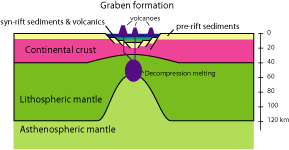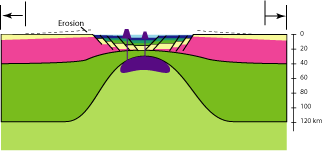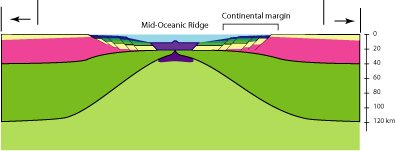|
|
|
Development of Continental Rifts |
|
|
|
Early ideas on the development of rifts are conceptualised in the diagram on the right based on the African rift system, where there is significant rift magmatism. There is notable extension by at least 50 km. At the same time there is ascent of the ductile mantle, especially the asthenosphere. The rift development can be summarized in 3 stages:
•1/ symmetric normal faults begin to form in the brittle crust along with simultaneous necking of the lithosphere with uprise of an asthenosphere diapir. The decompression associated with the latter causes melting of the mantle to give basaltic magmas. Pre-existing sediments are downfaulted into the graben.
•The second stage is accompanied by significant extension and more uprise of the asthenosphere. The latter causes doming of the crust. New sediments are deposited within the graben as a result of erosion of the uplifting sides of the graben. So there are both pre-rift and syn-rift sediments within the developing rift valley, but sediments on the flanks are progressively eroded away.
•The third stage shows the actually rifting-apart of the continent, so the asthenosphere rises towards the surface, causing decompression and extensive melting. New basaltic oceanic crust is formed. Eventually, sea-floor spreading takes over as the ocean basin widens. The rift sedimentary sequence is buried beneath younger marine sediments. |
|
|
|
 |
|
|
 |
|
|
 |
|
|
|
|
|
|
|
|
|
|
|